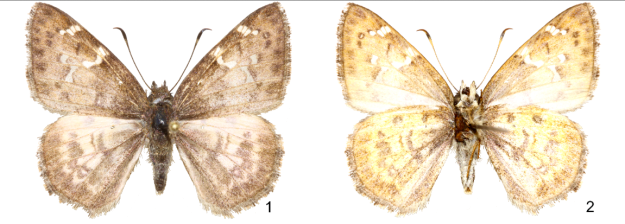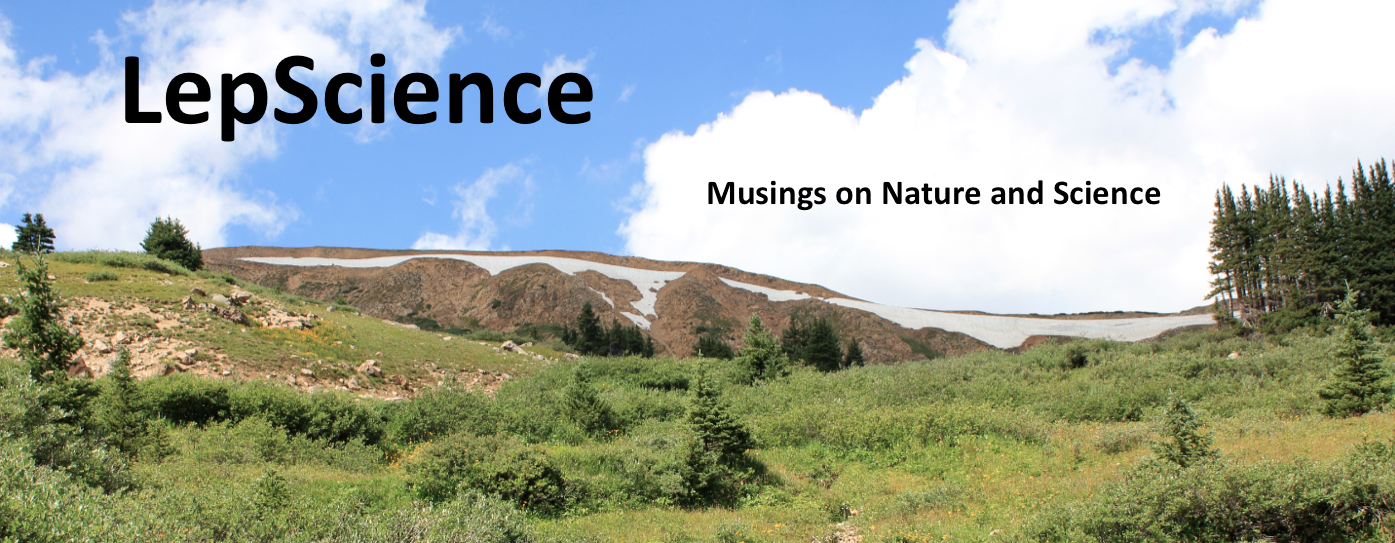In the late 1950’s, Lepidopterist William Harry Evans revised the New World fauna of skipper butterflies (Evans 1951, 1952, 1953, 1955), based on specimens in the British Museum of Natural History (now The Natural History Museum), in London. In his third volume (1953), Evans reviewed the genus Cogia– with twelve species known at the time, including a new species from Guatemala. As Evans frequently did when naming new skipper species and subspecies (he named hundreds of them), he used the locality name of the type specimens as a basis for the name of his new species from Guatemala, resulting in… Cogia mala.

Holotype male of Cogia mala, upperside (3) and underside (4), from Guatemala. Photos by Nick Grishin.
I don’t know if Evans understood Spanish, but if he did, he must not have liked Cogia mala very much. In Spanish, “mala” means “bad”- so his new species in its home country became the “bad Cogia.” “Cogia” has a variety of potential meanings across Spanish-speaking countries (and some of them, combined with mala, would likely be considered inappropriate and/or offensive).
I’ve always felt a bit bad for Cogia mala; it is a fine little skipper, and I’ve failed to detect anything “bad” about it, other than, perhaps, its highly restricted distribution (known only from Guatemala) and rarity in collections. There is no way to change the name Evans gave it, thanks to the rules of the International Code of Zoological Nomenclature. However…..
Upon recognizing a new species of Cogia in Mexico a few years ago, which appears to be the closest known relative of Cogia mala, I saw a unique opportunity to do something about the “bad Cogia” situation…

Holotype male of Cogia buena, upperside (1) and underside (2), from Oaxaca, Mexico. Photos by Andrew D. Warren.
Meet Cogia buena, the “Good Cogia”! This species was recently described from Oaxaca, Mexico (Warren et al. 2015). Most taxonomists, when possible, like to have fun with names, so we jumped at the opportunity to do something good for the genus Cogia.
Cogia buena is thus far known only from the southern Mexican state of Oaxaca. The Good Cogia could have been named several years ago, after the first known males confirmed it represented a new species, but we were waiting, hoping to find female specimens. However, years passed and no females turned up in collected material, so we’ve named Cogia buena from a series of 44 males. It will be good when the female is finally found and described, so we may better understand the relationship of Cogia buena to C. mala and other related species.
A more detailed study of the genus Cogia is currently in progress by Warren and collaborators.

View from near the type locality of Cogia buena, in the Sierra Madre del Sur of Oaxaca, Mexico, June, 2008.
Literature Cited:
Evans, W. H. 1951. A Catalogue of the American Hesperiidae Indicating the Classification and Nomenclature Adopted in the British Museum (Natural History). Part I. Introduction and Pyrrhopyginae. London, British Museum (Natural History): x + 92 pp., pls. 1-9.
Evans, W. H. 1952. A Catalogue of the American Hesperiidae Indicating the Classification and Nomenclature Adopted in the British Museum (Natural History). Part II. Pyrginae, Section I. London, British Museum (Natural History): vi + 178 pp., pls. 10-25.
Evans, W. H. 1953. A Catalogue of the American Hesperiidae Indicating the Classification and Nomenclature Adopted in the British Museum (Natural History). Part III. Pyrginae, Section II. London, British Museum (Natural History): vi + 246 pp., pls. 26-53.
Evans, W. H. 1955. A Catalogue of the American Hesperiidae Indicating the Classification and Nomenclature Adopted in the British Museum (Natural History). Part IV. Hesperiinae and Megathyminae. London, British Museum (Natural History): vi + 499 pp., pls. 54-88.

